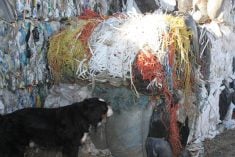The plants of the native prairie have been in decline since the first farmer tilled the first furrow and the first bushel of grain was harvested.
Reclaiming plants that are as old as the land itself and raising them as crops is new to many producers, but market opportunities are growing.
“It is perceived by both growers and buyers that the demand is outstripping supply. We weren’t able to confirm this … but more than 50 percent of those we surveyed said they sold their entire crop from this season already,” said Mary Ellen Hodgins, a Saskatoon-based consultant who prepared a market analysis for the Native Plant Society of Saskatchewan.
Read Also

Message to provincial agriculture ministers: focus on international trade
International trade stakeholders said securing markets in the face of increasing protectionism should be the key priority for Canada’s agriculture ministers.
Determine trends
Hodgins told the society at its annual meeting at Saskatoon’s Crop Production Week held Jan. 6-11 that even though growers of native plants are “a very secretive lot,” she was able to establish the issues and trends that will affect current and prospective growers.
The majority of the market appears to be with the oil and gas industry as it is required to restore the land after disturbances such as pipeline and oil or gas drilling and pumping. Another area is the surge in native gardening by baby boomers.














